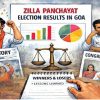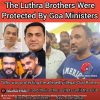Goa is abuzz with excitement as vintage bike and car owners, users, collectors and fans are decking […]

340 LUXURY FLATS DEMOLISHED IN KOCHI!
Oct 12- Oct 18 2019, SC Judgement October 11, 2019DEMOLITION: On May 8, a Supreme Court bench of Justices Arun Mishra and Navin Sinha ordered the demolition of four apartment complexes
By Uma Vishnu
Acting tough in implementing the Costal Regulation Act over five luxury buildings containing 350 luxury flats have been ordered to be demolished in Cochin in Kerala. It will not be long before many high rise building and gated colonies are demolished in Goa also. The Bambolim Hyatt is among the many hotels which have received notice for demolition under the CRZ Act
Come October 11, four Kochi apartment complexes will be brought down as the Supreme Court goes by the letter on stringent coastal rules. The Indian Express finds 1,500 people without home and at a loss for options.
“Amma, you can’t lie down today. You’ll have to sit around somewhere. We will figure out something for you by night,” the domestic help tells Shantamma. On the 90-year-old’s bed are suitcases and assorted rods, and plaster chipped off from the adjoining wall, where workers have just removed the air conditioner. The large balcony window, by which she had spent countless evenings looking at the ferries and boats carrying honeymooners from the Le Meridien suite down the waterfront, is now a skeletal aluminium frame, the glass dismantled.
Shantamma blinks back tears and, wheezing as she leans heavily on her quadripod walking stick, mumbles, “Enne kondu bharam matram (I am of no use, just a burden).”
It was in 2011 that Shantamma and her daughter Maya Premmohan moved into this three-bedroom apartment in Holy Faith H2O, an upmarket residential building by the Kundanoor backwaters in Kochi city, one of four apartment complexes that are now under the demolition hammer over alleged violation of Coastal Regulation Zone (CRZ) rules.
“Maya bought this flat after selling her share of her late husband’s ancestral property in Thiruvananthapuram. Her elder daughter in Kuwait pitched in with some money too. When we moved here, I thought Maya could finally relax. She was in her 30s when her husband died, leaving her with her two daughters and a lifetime of struggle,” says Shantamma, adding that Maya is out looking for a flat to rent. “She is not young either… 60, not the age to be running around like this.”
On May 8, a Supreme Court bench of Justices Arun Mishra and Navin Sinha ordered the demolition of four apartment complexes, with 343 flats in all — of which 326 are occupied — in the Maradu municipality area of Kochi in Kerala’s Ernakulam district over alleged violation of CRZ guidelines. These buildings, like several others in the municipality and the larger Ernakulam district, are by the banks of a network of canals and backwaters that snake their way through the region before draining their waters into the Vembanad lake further south.
With days left for the court mandated deadline of October 11 for the buildings to be brought down, and with at least two review petitions struck down by the apex court, most of the families in H2O and the other three buildings — Golden Kayaloram, Alfa Serene and Jains Coral Cove — have decided that they have little option but to move out.
They hope to take along anything they can salvage before the “controlled explosion” that the district administration is preparing to carry out.
“It shouldn’t take more than half a day. We will evacuate people in about 11,000 homes in a 1-km radius of each of these apartments, and they can come back after the dust has settled down. It will all be done very scientifically,” says an official in the Ernakulam district administration. “See, we don’t want to use force,” he says of the residents, some of whom have decided to dig in for as long as they can. “We have told them they can take whatever they want, but must leave within the deadline. We don’t have a choice, our hands are tied by the court order.”
By now, Shantamma has slowly made her way to the living room, settled down on the sofa and caught her breath: “What was wrong with this house? Why do they want to bring it down? And where will we take all this?”
The workers look up at Shantamma, smile. The doors and glass panes of windows have been stacked in a corner, a worker lies down on one of the beds for a break, and the walls have been stripped of everything except the wallpaper and the nails that once held memories of better times.
Two floors below, in the ritzy lobby of H2O, residents discuss their moving-out plans, and submit their documents — ownership papers and bank accounts, among others — to municipal authorities who come calling every now and then. On September 30, with the Supreme Court striking down another writ petition filed by the flatowners from H2O that morning, there is little hope. The makeshift protest site, where some residents had turned up until the previous day, has been wound up. Outside the gates are banners and flags put up by political parties in solidarity.
Among the few still left with some fight is Shamsudeen Karunagapally, an H2O resident and chairman of the Maradu Home Protection Council. “The court order is like the blow of a hammer on our heads. They have dismissed all our petitions without even considering the worth of the paper on which they are printed,” he says.
While the administration has agreed to help the house owners find temporary accommodation, apart from the `25 lakh that the apex court ordered as interim compensation, Karunagapally alleges the promises are “baseless”. “Yesterday, after a meeting, the district administration gave us a list of 50 high-class flats as temporary accommodation. But when we called on the numbers listed, the property owners denied that they were letting out their flats. In fact, some of them yelled, asking why we were calling them again and again. We won’t move out unless we get alternative accommodation.”
The administration, however, denies the list is faulty. “First of all, they should have gone through us, instead of calling on the numbers themselves. Some of them even started negotiating with the property owners, telling them to waive off the rent till they got the compensation from the government. Now, why would anyone let out his flat for free?”
As the hammers come down on the remaining air conditioners, wardrobes and other fittings, the beguilingly still Vembanad waters carry their echoes far beyond the four apartment buildings. The demolition and the Supreme Court ruling have raised questions over the interpretation and implementation of CRZ rules that mandate the minimum distance between a water body and any construction activity, and which have seen successive amendments and multiple court rulings.
In its May 8 ruling, the court had upheld the contention of the Kerala State Coastal Zone Management Authority, the agency responsible for implementing CRZ rules in the state, that the area on which the four buildings stood fell under CRZ-III, making them critically vulnerable and thus forbidding construction within 200 metres of the high-tide line. Experts say it’s a condition that would render several buildings in the city illegal.
Additional Chief Secretary (local self-government) T K Jose had earlier said that while an exercise to identify CRZ violations was still on, they suspect at least 800 such violations in Maradu alone.
In the lobby of Golden Kayaloram, a 40-flat building along the Champakara canal and the least adorned of the four slated for demolition, neighbours Shubha Rajmohan and Tara Anup John discuss how their building has been unfairly clubbed with the others since their facts and pleas are “distinct” — the basis for a curative petition pending in the Supreme Court. Behind them, an indoor plant holds up a child’s poster: “Save My Home”, it reads.
“What you see here is Champakara canal. It’s a man-made canal. There’s also a public road and a municipality building (an anganwadi) separating us from the canal. How can it fall under CRZ-III?” says Tara, adding that since the Supreme Court order, they have spent countless evenings here in the lobby discussing what can possibly save their homes.
“Our lives have come to a halt. Nobody wants to cook or do anything else. It all seems so pointless. Some of the younger children haven’t been going to school and some of our children, who have settled in other cities and countries, have had to rush home to help their parents move out,” says Shubha.
Around her, as residents make multiple rounds to their cars, filling trunks with cardboard cartons and photo frames, she adds, “It’s just so hopeless. Do you think there’s any chance that our homes won’t be pulled down?”
While that’s the most pressing question among residents, the impending demolition has also raised questions of whether there could have been another way out.
Harish Vasudevan, an advocate who specialises in environmental law, says questions of whether the constructions are legal or illegal and if illegal, should they be regularised or demolished, need to be addressed by the executive, not the judiciary. “If there was a CRZ violation, someone should issue a notice saying the construction is illegal. If the other party has an objection, they have a statutory remedy now in the NGT. If the authority thinks it is bad in law, they can decide whether to demolish or regularise. That process was totally absent here. The Kerala Coastal Zone Management Authority never issued a notice to the builders or directed them to stop construction. When the Supreme Court took up the matter, the question before them was whether the notice issued by Maradu municipality is right or wrong. The SC’s power stops where the notice starts. More than the environmental damage, I am worried about this dilution of the system/procedure. When Parliament gives a statutory right for you to challenge a notification affecting you, how can those procedures be taken away by the Supreme Court without reasonable orders?”
P S: Maya has sent Shantamma to a “centre” nearby. “That way, I don’t have to drag her through all this. I have been spending the nights at a friend’s home, and go back to the flat every morning,” she says.
Courtesy: Indian Express

















